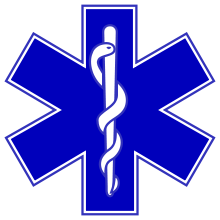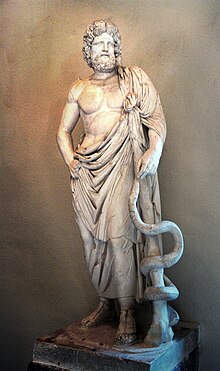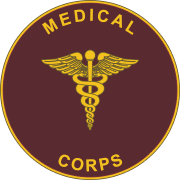Rod of Asclepius

In Greek mythology, the Rod of Asclepius (⚕; /æsˈkliːpiəs/, Ancient Greek: Ῥάβδος τοῦ Ἀσκληπιοῦ, Rhábdos toû Asklēpioû, sometimes also spelled Asklepios), also known as the Staff of Aesculapius and as the asklepian,[1] is a serpent-entwined rod wielded by the Greek god Asclepius, a deity associated with healing and medicine. In modern times, it is the predominant symbol for medicine and health care, although it is sometimes confused with the similar caduceus, which has two snakes and a pair of wings.[1]
Greek mythology and Greek society

The Rod of Asclepius takes its name from the Greek god Asclepius, a deity associated with healing and medicinal arts in ancient Greek religion and mythology. Asclepius' attributes, the snake and the staff, sometimes depicted separately in antiquity, are combined in this symbol.[2][full citation needed]
The most famous temple of Asclepius was at Epidaurus in north-eastern Peloponnese.[3] Another famous healing temple (or asclepeion) was located on the island of Kos, where Hippocrates, the legendary "father of medicine", may have begun his career. Other asclepieia were situated in Trikala, Gortys (Arcadia), and Pergamum in Asia.
In honour of Asclepius, a particular type of non-venomous rat snake was often used in healing rituals, and these snakes – the Aesculapian snakes – crawled around freely on the floor in dormitories where the sick and injured slept. These snakes were introduced at the founding of each new temple of Asclepius throughout the classical world. From about 300 BCE onwards, the cult of Asclepius grew very popular and pilgrims flocked to his healing temples (Asclepieia) to be cured of their ills. Ritual purification would be followed by offerings or sacrifices to the god (according to means), and the supplicant would then spend the night in the holiest part of the sanctuary – the abaton (or adyton). Any dreams or visions would be reported to a priest who would prescribe the appropriate therapy by a process of interpretation.[4] Some healing temples also used sacred dogs to lick the wounds of sick petitioners.[5][6]
The original Hippocratic Oath began with the invocation "I swear by Apollo the Healer and by Asclepius and by Hygieia and Panacea and by all the gods ..."[5]
The serpent and the staff appear to have been separate symbols that were combined at some point in the development of the Asclepian cult.[7] The significance of the serpent has been interpreted in many ways; sometimes the shedding of skin and renewal is emphasized as symbolizing rejuvenation,[8][a] while other assessments center on the serpent as a symbol that unites and expresses the dual nature of the work of the Apothecary Physician, who deals with life and death, sickness and health.[10] The ambiguity of the serpent as a symbol, and the contradictions it is thought to represent, reflect the ambiguity of the use of drugs,[8] which can help or harm, as reflected in the meaning of the term pharmakon, which meant "drug", "medicine", and "poison" in ancient Greek.[11] However the word may become less ambiguous when "medicine" is understood as something that heals the one taking it because it poisons that which afflicts it, meaning medicine is designed to kill or drive away something and any healing happens as a result of that thing being gone, not as a direct effect of medicine. Products deriving from the bodies of snakes were known to have medicinal properties in ancient times, and in ancient Greece, at least some were aware that snake venom that might be fatal if it entered the bloodstream could often be imbibed. Snake venom appears to have been prescribed in some cases as a form of therapy.[12]
The staff has also been variously interpreted. One view is that it, like the serpent, "conveyed notions of resurrection and healing", while another (not necessarily incompatible) is that the staff was a walking stick associated with itinerant physicians.[13] Cornutus, a Greek philosopher probably active in the first century CE, in the Theologiae Graecae Compendium (Ch. 33) offers a view of the significance of both snake and staff:
Asclepius derived his name from healing soothingly and from deferring the withering that comes with death. For this reason, therefore, they give him a serpent as an attribute, indicating that those who avail themselves of medical science undergo a process similar to the serpent in that they, as it were, grow young again after illnesses and slough off old age; also because the serpent is a sign of attention, much of which is required in medical treatments. The staff also seems to be a symbol of some similar thing. For by means of this it is set before our minds that unless we are supported by such inventions as these, in so far as falling continually into sickness is concerned, stumbling along we would fall even sooner than necessary.[9]: 13
In any case, the two symbols certainly merged in antiquity as representations of the snake coiled about the staff are common.[6]
Confusion with the caduceus

It is relatively common, especially in the United States, to find the caduceus, with its two snakes and wings, (mis)used as a symbol of medicine instead of the Rod of Asclepius, with only a single snake. This usage was popularized by the adoption of the caduceus as its insignia by the U.S. Army Medical Corps in 1902 at the insistence of a single officer (though there are conflicting claims as to whether this was Capt. Frederick P. Reynolds or Col. John R. van Hoff).[14][15]
The Rod of Asclepius is the dominant symbol for professional healthcare associations in the United States. One survey found that 62% of professional healthcare associations used the rod of Asclepius as their symbol.[16] The same survey found that 76% of commercial healthcare organizations use the caduceus. The author of the study suggests that professional associations are more likely to have a historical understanding of the two symbols, whereas commercial organizations are more likely to be concerned with the visual impact a symbol will have on its sales.[16]
The long-standing historical association of the caduceus with commerce has engendered significant criticism of its use in medicine. Medical professionals argue that the Rod of Asclepius better represents the field of medicine.[17] Writing in the journal Scientific Monthly, Stuart L. Tyson said of the Staff of Hermes (the caduceus):
As god of the high-road and the market-place Hermes was perhaps above all else the patron of commerce and the fat purse: as a corollary, he was the special protector of the traveling salesman. As spokesman for the gods, he not only brought peace on earth (occasionally even the peace of death), but his silver-tongued eloquence could always make the worse appear the better cause.[18] From this latter point of view, would not his symbol be suitable for certain Congressmen, all medical quacks, book agents and purveyors of vacuum cleaners, rather than for the straight-thinking, straight-speaking therapeutist? As conductor of the dead to their subterranean abode, his emblem would seem more appropriate on a hearse than on a physician's car.
— Stuart L. Tyson, "The Caduceus", in the Scientific Monthly, 1932[19]
Similar Biblical story
The rod of Asclepius has been likened to the Old Testament story of Moses's brazen serpent (also known as Nehushtan), a brass sculpture of a snake on a rod which had the power of protecting the Israelites from the bites of venomous snakes.[20]
Unicode
| ⚕ | |
|---|---|
Staff of Aesculapius | |
| In Unicode | U+2695 ⚕ STAFF OF AESCULAPIUS |
| Related | |
| See also | U+269A ⚚ STAFF OF HERMES U+1F54F 🕏 BOWL OF HYGIEIA |
A symbol for the rod of Asclepius has a code point (U+2695 ⚕ STAFF OF AESCULAPIUS) in the Miscellaneous Symbols table of the Unicode Standard: the spelling is theirs.
Modern use

A number of organizations and services use the rod of Asclepius as their logo, or part of their logo. These include:
Asia
- Beijing University of Chinese Medicine
- Chinese Medical Association
- Armed Forces Medical Services
- Army Medical Corps (India)
- Dental Council of India
- International Medical University, Malaysia
- Ministry of Health, Cambodia
- Ministry of Health and Welfare, Republic of China
- Ministry of Health of the People's Republic of China
- Ministry of Health, Myanmar
- Ministry of Health Vietnam
- Medical Council of India
- Pakistan Army Medical Corps
- Medical Corps (Israel)
Africa
- Kenya Medical Research Institute
- Kenya Medical Training College
- Nigerian Medical Association
- South African Medical Research Council former coat of arms
- South African Military Health Service
South Pacific
- Australian Medical Association
- Australian Medical Students' Association
- Medical Council of New Zealand
- Royal New Zealand Army Medical Corps
- Royal Australian Army Medical Corps
Canada
- Alberta Medical Association
- Canadian Association of Physicians for the Environment
- Canadian Dental Association
- Canadian Medical Association
- College of Physicians and Surgeons of Manitoba
- Medical Council of Canada
- Ottawa Paramedic Service
- Paramedic Association of Canada
- Royal Canadian Medical Service
- Royal College of Physicians and Surgeons of Canada
Europe
- Association of Anaesthetists of Great Britain and Ireland
- British Medical Association
- Royal Army Medical Service (UK)
- Emergency medical services in France (SAMU, SMUR, et al.)
- Emergency medical services in Italy
- Emergency medical services in the Netherlands
- Emergency medical services in the United Kingdom
- Emergency medical services in Portugal
- The London Clinic
- Royal College of Psychiatrists (UK)
- Royal Society of Medicine (UK)
- University of Copenhagen Faculty of Health and Medical Sciences
- Jessenius Faculty of Medicine (SVK)
United States
- Alabama College of Osteopathic Medicine
- American Academy of Family Physicians
- American Academy of Psychiatry and the Law
- American College of Osteopathic Internists
- American Medical Association
- American Medical Response
- American Medical Student Association
- American Osteopathic Association
- American Veterinary Medical Association
- Blue Cross Blue Shield Association (U.S.)
- Chicago College of Osteopathic Medicine
- Geisel School of Medicine (at Dartmouth)
- Heritage College of Osteopathic Medicine
- Hofstra School of Medicine
- Idaho College of Osteopathic Medicine
- International Medical Corps
- MedicAlert (U.S.)
- Michigan State Medical Society
- Morehouse School of Medicine
- National Athletic Trainers Association
- National Association of Emergency Medical Technicians
- National Registry of Emergency Medical Technicians
- New York University School of Medicine
- Stanford University School of Medicine
- Kansas City University of Medicine and Biosciences
- Student National Medical Association
- Student Osteopathic Medical Association (U.S.)
- United States Air Force Medical Corps
- University of Minnesota Medical School
- Yale University School of Medicine
Worldwide
- Medical Protection Society
- Star of Life, symbol of emergency medical services
- World Health Organization
Variation
In Russia, the emblem of Main Directorate for Drugs Control features a variation with a sword and a snake on the shield.
See also
- Aaron's rod – Staves carried by Moses's brother, Aaron, in the Torah
- Bowl of Hygieia – Symbol of pharmacy
- Chakra – Subtle body psychic-energy centers in the esoteric traditions of Indian religions
- Iron crutch (symbol of Traditional Chinese medicine)
- Nāga – Mythological creatures in Indian religions
- Nehushtan – Brass serpent in Torah
- Ningishzida – Mesopotamian god
- Phurba – Tibetan ritual implement
Notes
References
- ^ a b Wilcox, Robert A; Whitham, Emma M (15 April 2003). "The symbol of modern medicine: why one snake is more than two". Annals of Internal Medicine. 138 (8): 673–7. doi:10.7326/0003-4819-138-8-200304150-00016. PMID 12693891. S2CID 19125435. Retrieved 15 June 2007.
- ^ See for example Pausanias, Description of Greece 2.26.1–28.1 (here translated by Jones) 2nd A.D.: "The image of Asklepios is, in size, half as big as Zeus Olympios at Athens, and is made of ivory and gold. An inscription tells us that the artist was Thrasymedes, a Parian, son of Arignotos. The god is sitting on a seat grasping a staff; the other hand he is holding above the head of the serpent."
- ^ "Sanctuary of Asklepios at Epidaurus". UNESCO World Heritage Convention. United Nations Educational Scientific and Cultural Organization. Retrieved 12 November 2022.
- ^ Sigerist, Henry Ernest (1987). "3, Religious medicine: Asclepius and his cult". A History of Medicine. Vol. 2: Early Greek, Hindu and Persian medicine. Oxford University Press. pp. 64, 65.
- ^ a b Farnell, Lewis Richard (1921). "Chapter 10, "The Cult of Asklepios"". Greek hero cults and ideas of immortality : the Gifford lectures delivered in the University of St. Andrews in the year 1920. Oxford: Clarendon Press.
- ^ a b Hart, Gerald David; Forrest, Martin St. J. (1999). Asclepius: The God of Medicine. London: Royal Society of Medicine Press. p. 42. ISBN 9781853154096. OCLC 42579033.
- ^ Lock, Stephen; Last, John M.; Dunea, George (2001). The Oxford Illustrated Companion To Medicine (3rd ed.). Oxford University Press. p. 261. ISBN 9780192629500. OCLC 46678589.
In early statues of Asclepius the rod and serpent were represented separately.
- ^ a b Jonsen, Albert R. (1990). The New Medicine and the Old Ethics. Harvard University Press. pp. 122, 123. ISBN 9780674617254. OCLC 21227464.
Asklepios' reptile was a healing creature: in ancient mythology the snake, whose skin was shed and rejuvenated, symbolized eternity and restoration of life and health
- ^ a b Edelstein, Emma J; Edelstein, Ludwig, eds. (1975) [1945]. Asclepius: A Collection and Interpretation of the Testimonies. New York: Arno Press. ISBN 9780405070099. OCLC 2021782.
- ^ Schouten, Jan (1967). The Rod and Serpent of Asklepios, Symbol of Medicine. Amsterdam: Elsevier. p. 2. OCLC 657667.
[...] the ancient conception of the serpent as the embodiment of the mystery of one absolute life of the earth, which entails a continual dying and resurrection [...] the combination of corruption and salvation, of darkness and light, of good and evil in the Asklepian symbol.
- ^ Sigerist, Henry Ernest (1987). "2, Homeric medicine". A History of Medicine. Vol. 2: Early Greek, Hindu and Persian medicine. Oxford University Press. pp. 27–28.
- ^ Kelhoffer, James A. (2000). Miracle and mission : the authentication of missionaries and their message in the longer ending of Mark. Tübingen: Mohr Siebeck. pp. 438–439.
[...] it was known, at least by some people in antiquity, that a snake's venom is not harmful if imbibed, but rather only if it enters directly into a person's blood stream. For example, the first-century CE historian Lucan writes that the younger Cato, when leading his troops through Libya during the Roman Civil War, informed his men about this very point [...] 'The poison of snakes is only deadly when mixed with the blood; their venom is in their bite, and they threaten death with their fangs. There is no death in the cup.'" He also mentions an account of Cornelius Celsus (first century CE) "'For a serpent's poison, like certain hunter's poisons..., does no harm when swallowed, but only in a wound'". "Likewise, Galen relates a rather peculiar healing by Asclepius involving viper's venom. The god appeared to a wealthy man in Pergamum and prescribed 'that he should drink every day of the drug produced from the vipers and should anoint the body from the outside.' [...] The elder Philostratus describes a similar practice of 'the wise Asclepiads,' who 'heal the bites of venomous creatures... using the virus itself as a cure of many diseases'.
- ^ Menez, Andre (2003). The Subtle Beast, Snakes From Myth to Medicine. London: Taylor & Francis. p. 14. ISBN 9780415284981. OCLC 59462472.
- ^ F.H. Garrison, "The Use of the Caduceus in the Insignia of the Army Medical Officer", in Bull. Med. Lib. Assoc. IX (1919-20), 13-16
- ^ Engle, Bernice (December 1929). "The Use of Mercury's Caduceus as a Medical Emblem"". The Classical Journal. 25 (1): 205.
- ^ a b Friedlander, Walter J (1992). The Golden Wand of Medicine: A History of the Caduceus symbol in medicine. Greenwood Press. ISBN 0-313-28023-1.
- ^ Bohigian, George (2019). "The Caduceus vs. Staff of Aesculapius - One Snake or Two?". Missouri Medicine. 116 (6): 476–477.
"The Staff of Aesculapius has represented medicine since 800 BCE and most authorities support its use as the symbol of medicine
- ^ An allusion to John Milton's description of Belial in Paradise Lost II.113-114.
- ^ Tyson, Stuart L (1932). "The Caduceus". Scientific Monthly. 34 (6): 495.
- ^ Hart, Gerald David; Forrest, Martin St. J. (1999). Asclepius: The God of Medicine. London: Royal Society of Medicine Press. p. 237-238. ISBN 9781853154096. OCLC 42579033.
External links
 Media related to Rod of Asclepius at Wikimedia Commons
Media related to Rod of Asclepius at Wikimedia Commons

